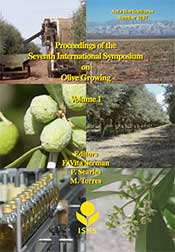Ver ítem
- xmlui.general.dspace_homeCentros Regionales y EEAsCentro Regional Mendoza - San JuanEEA San JuanArtículos científicosxmlui.ArtifactBrowser.ItemViewer.trail
- Inicio
- Centros Regionales y EEAs
- Centro Regional Mendoza - San Juan
- EEA San Juan
- Artículos científicos
- Ver ítem
Detoxification of alperujo using solid-state fermentation: statistic optimization of the process
Resumen
The alperujo (AL) is the waste produced by the process of olive oil extraction using two phase systems. The AL is a very contaminant residue and its direct disposal is not allowed in Argentine. Moreover, seasonality of the production motivates the accumulation of great amounts of AL, to be handled in short time. The organic fraction of AL includes polyphenolic compounds, reported as responsible for its antibiosis and phytotoxicity. The use of
[ver mas...]
The alperujo (AL) is the waste produced by the process of olive oil extraction using two phase systems. The AL is a very contaminant residue and its direct disposal is not allowed in Argentine. Moreover, seasonality of the production motivates the accumulation of great amounts of AL, to be handled in short time. The organic fraction of AL includes polyphenolic compounds, reported as responsible for its antibiosis and phytotoxicity. The use of biotechnological processes, alone or combined with physic-chemical procedures, has been recommended for the treatment of the AL. However, there are not yet processes that solve environmental and economic drawbacks, in a satisfactory way. The solid-state fermentations (SSF), including composting, are biotechnological treatments proper to be applied to the AL, with the aim of detoxifying and reducing its mass, to allow its reuse and/or final disposal. The objective of the present work is to assess the optimal conditions for the relevant variables for the AL detoxification by SSF. Twelve lab-scale SSF experiences were done for the selection of the relevant variables using the Plackett-Burman design. The variables taken into account were: inoculums, oil-extraction, time, initial humidity (H), initial pH, temperature, sterility, structural support (SS), PO4(NH4)2, and SO4Cu. As response, the polyphenol loss was evaluated (PPL). The variables SO4Cu, H and SS were found as the most relevant, and these were optimized by the Box-Behnken method (15 new experiments were carried out). The optimal values determined were H: 47.9%, SO4Cu: 4.66%, SS: 36.29%; whereas at 14 days, the maximum PPL achieved was 9.8 mg/g of dried matter, which represents more than 94% of original polyphenolic content. Results are encouraging and bench-scale SSF experiences studying aeration and mixing will be soon reported.
[Cerrar]

Autor
Rodríguez, L.;
Gouiric, S.;
Vallejo, M.;
Monetta, Pablo Miguel;
Descripción
Trabajo presentado al VII International Symposium on Olive Growing, 2014
Fuente
Acta Horticulturae 1057 : 655-660 (Oct. 2014)
Fecha
2014-10-30
Editorial
ISHS
ISSN
0567-7572
2406-6168
2406-6168
ISBN
978-94-62610-47-7
Formato
pdf
Tipo de documento
artículo
Palabras Claves
Derechos de acceso
Restringido
 Excepto donde se diga explicitamente, este item se publica bajo la siguiente descripción: Creative Commons Attribution-NonCommercial-ShareAlike 2.5 Unported (CC BY-NC-SA 2.5)
Excepto donde se diga explicitamente, este item se publica bajo la siguiente descripción: Creative Commons Attribution-NonCommercial-ShareAlike 2.5 Unported (CC BY-NC-SA 2.5)

